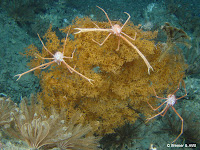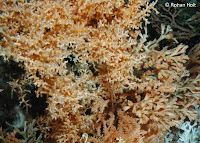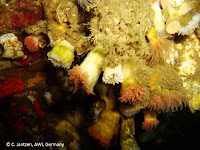Cold-water coral reefs are home to thousands of other species, in particular animals like sponges, polychaetes (or bristle worms), crustaceans (crabs, lobsters), molluscs (clams, snails, octopuses), echinoderms (starfish, sea urchins, brittle stars, feather stars), bryozoans (sea moss) and fish. The Changing Oceans Cruise will be sampling just some of these creatures to examine on the ship, but we hope to have video footage of many others. More information about the creatures found on and around deep sea coral reefs can be found at
Lophelia.org
Cold-water corals
The word coral conjures images of tropical waters with colourful reefs within snorkelling distance of the shore. These are tropical corals and are among the most studied and loved ecosystems on earth. It may surprise people to hear that corals aren't just found in the tropics. The cold, dark waters of the deep-ocean are home to cold-water coral reefs, and the Changing Oceans cruise will be studying the spectacular reefs of Mingulay and Rockall Bank.
Lophelia pertusa

Lophelia is the most abundant and widespread reef-framework forming cold-water coral, found in almost all of the world’s oceans.
Lophelia reefs at Mingulay are found between 120 and 190 m depth, which are relatively shallow for these corals. In fact, Lophelia is usually found at depths of hundreds of meters, and has even been recorded at 3,383 m in the North Atlantic. Around Rockall bank,
Lophelia is found with
Madrepora, down to 1000 m depth. Coral colonies and thickets are scattered around the shallower parts of the bank from 150-400 m depth whereas large reef structures are found below 500 m on the eastern flank. These reefs partly form mounds up to 350 m high. Although most
Lophelia is white in colour, it can also be found in several colour variations, with yellow, orange or red patterns. We hope to spot some of these coloured corals on this cruise!
Madrepora oculata
In structure, Madrepora looks like a skinny version of Lophelia, and thus is too fragile to form large reef structures. Madrepora, also known as the zigzag coral, is one of the most abundant reef building species worldwide. It is common in the north Atlantic, often found among Lophelia colonies, which is where we will be searching!
|
|
Desmophyllum dianthus
Desmophyllum is a solitary cup coral, with a cosmopolitan distribution from the sub-Antarctic to the North Sea. Although it is a solitary coral, Desmophyllum can form important reef-like structures in areas where it is abundant. It is an important coral for us to collect, as it is an archive of intermediate water mass and wider oceanic climate change – basically we can use this coral to work out oceanic temperature and chemistry thousands of years ago.
|
|
Sponges
Sponges is the common name for a group of animals called Porifera, which means 'pore-bearer'. They are simple animals which live permanently attached to solid surfaces such as dead coral framework. They have tiny pores in their outer walls, through which
water is drawn - this water brings in tiny bits of food that the cells in the sponge walls pick up as the water is pumped through the body and out other larger
openings. Sponge species which we hope to collect and study include Mycale lingua, Hymedesmi, Axinella infundibuliformis, and Rosella nodastrella. |
|
Crustaceans
Animals in the class Crustacea (of the phylum Arthropoda) include lobsters, crabs, copepods, shrimps and barnacles. These animals often have heavily armoured carapaces (protective shells) with a rigid external skeleton made of chitin and other proteins. Most crustacea move around, and there are a great number of species found living in and around cold-water coral reefs. This image shows three squat lobsters (Gastroptychus formosus), which are commonly found sitting on cold-water corals. |
 |
Polychaetes
Polychaetes are segmented worms, among the most diverse and abundant organisms collected on deep sea coral reefs.These small bodied worms often have stiff bristles on their sides, which allow them to burrow, crawl and swim. One species we know we will encounter is the eunicid bristleworm, Eunice norvegica, which lives in a parchment tube on the surface of Lophelia pertusa and other cold-water corals.We will be have to very careful when we collect these worms as they bite! |

|
Molluscs
Molluscs are a group of highly diverse animals which have a soft body, and typically a 'head' and foot' region. Molluscs we are likely to find at the cold-water coral reefs include nudibranchs (sea-slugs), clams, snails, and limpets. Cephalopods (squid and octopus) are also common; these complex molluscs have elaborate
nervous systems, a distinct head, suckered arms, and large brains and eyes. |
|
Echinoderms
Echinoderms are marine animals which usually have a fivefold symmetry, with rays or arms in fives or multiples of five. They also have a system of internal
water-filled canals, which in many echinoderms form suckered
"tube feet", with which the animal may move or grip objects. Echindoerm species we may find on the cold-water coral reefs include echinoids (sea urchins), asteroids (starfish), ophiurids (brittle stars) and holoturids (sea cucumbers).
|
|
Bryozoans
Bryozoans, or 'moss animals' are commonly mistaken for sponges or corals.Bryozoans have been discovered in great numbers and in an amazing diversity of shapes in the deep-sea.They mostly live in colonies of interconnected individuals (zooids); a few to many millions of these individuals may form one colony. Each zooid is enclosed in a protective box-like exoskeleton, with apertures for ciliated feeding structures known as lophophores. In the deep-sea, there are some large bryozoan forms, but most are small, fragile and rarely collected intact.
|
|
Fish
Like tropical coral reefs, cold-water reefs attract huge numbers of fish, forming shoals, circling above. These fish may never stray far from the reef, depending on it for food and shelter. The reefs seem to
provide important habitats for fish like redfish (Sebastes spp.), perhaps giving them shelter to spawn their young. Some common species of fish observed on and around cold-water coral reefs include: wolf fish (Anarhichas lupus), tusk (Brosme brosme, ling (Molva molva), orange roughy (Hoplostethus atlanticus), monkfish (Lophius piscatorius), cod (Gadus macrocephalus) and many others.
Catshark (Galeus melastomus)
We recently discovered catshark eggs amongst the cold-water corals at Mingulay, and will be on the lookout for more on this cruise. The
deep-water blackmouth catshark is found cruising just above the seabed at depths of 200 to 1200 m, and lays its eggs within the protective coral
framework. As well as being a nursery area for these cat sharks, the cold-water coral reefs of Mingulay are also home to a plentiful food
supply for the adult and juvenile sharks, who like to feed on cephalopods, fish and crustaceans.
|
|
|
 Lophelia is the most abundant and widespread reef-framework forming cold-water coral, found in almost all of the world’s oceans. Lophelia reefs at Mingulay are found between 120 and 190 m depth, which are relatively shallow for these corals. In fact, Lophelia is usually found at depths of hundreds of meters, and has even been recorded at 3,383 m in the North Atlantic. Around Rockall bank, Lophelia is found with Madrepora, down to 1000 m depth. Coral colonies and thickets are scattered around the shallower parts of the bank from 150-400 m depth whereas large reef structures are found below 500 m on the eastern flank. These reefs partly form mounds up to 350 m high. Although most Lophelia is white in colour, it can also be found in several colour variations, with yellow, orange or red patterns. We hope to spot some of these coloured corals on this cruise!
Lophelia is the most abundant and widespread reef-framework forming cold-water coral, found in almost all of the world’s oceans. Lophelia reefs at Mingulay are found between 120 and 190 m depth, which are relatively shallow for these corals. In fact, Lophelia is usually found at depths of hundreds of meters, and has even been recorded at 3,383 m in the North Atlantic. Around Rockall bank, Lophelia is found with Madrepora, down to 1000 m depth. Coral colonies and thickets are scattered around the shallower parts of the bank from 150-400 m depth whereas large reef structures are found below 500 m on the eastern flank. These reefs partly form mounds up to 350 m high. Although most Lophelia is white in colour, it can also be found in several colour variations, with yellow, orange or red patterns. We hope to spot some of these coloured corals on this cruise!










